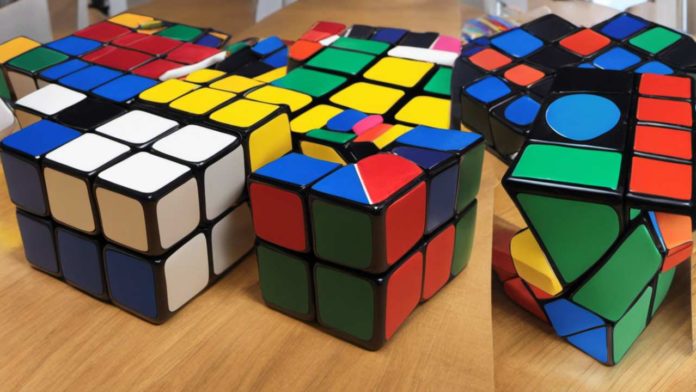How to Solve a 3×3 Jumbled Rubik’s Cube?
Introduction
The Rubik’s Cube is a popular puzzle that has captured the fascination of people around the world since its invention in 1974. Solving a jumbled Rubik’s Cube can be a challenging task, but with the right techniques and strategies, it is possible to solve it step by step. In this article, we will explore the process of solving a 3×3 Rubik’s Cube, providing detailed instructions and tips to help you successfully solve the puzzle.
Understanding the Rubik’s Cube
Before diving into the solving process, it is important to understand the structure and mechanics of the Rubik’s Cube. The 3×3 Rubik’s Cube consists of six faces, each composed of nine smaller squares. The cube can be rotated along its axes, allowing for various combinations and permutations of the smaller squares. The goal of the puzzle is to arrange all the squares on each face so that each face is a single color.
Notation
To describe the movements and rotations of the Rubik’s Cube, a standard notation system is used. The six faces of the cube are labeled as follows:
– U: Upper face
– D: Down face
– L: Left face
– R: Right face
– F: Front face
– B: Back face
Each face can be rotated clockwise (indicated by the letter alone) or counterclockwise (indicated by adding an apostrophe after the letter). Double turns are indicated by adding the number 2 after the letter.
The Layer Method
The layer method is a systematic approach to solving the Rubik’s Cube by solving one layer at a time. It involves several steps, each aimed at solving a specific portion of the cube.
Step 1: Solving the First Layer
The first step in solving a jumbled Rubik’s Cube is to solve the first layer. This involves solving the four edges and the four corners of the first layer.
1. Start by choosing a color to solve first. This will be the color of the center square on one face of the cube.
2. Find the edge pieces that have the chosen color and place them in their correct position on the first layer. This can be done by rotating the cube and manipulating the other layers.
3. Once the edge pieces are in place, solve the corner pieces by manipulating the cube and the other layers.
Step 2: Solving the Second Layer
After solving the first layer, the next step is to solve the second layer. This involves solving the four edges of the second layer.
1. Rotate the cube so that the first layer is facing down.
2. Locate the edge pieces that need to be solved in the second layer.
3. Use specific algorithms to move the edge pieces into their correct positions.
Step 3: Solving the Final Layer
The final step in solving a Rubik’s Cube is to solve the final layer. This involves solving the four edges and the four corners of the final layer.
1. Rotate the cube so that the solved layers are facing down.
2. Solve the edge pieces of the final layer by using specific algorithms.
3. Solve the corner pieces of the final layer by using specific algorithms.
Step 4: Finishing Moves
Once the final layer is solved, there may be some misaligned pieces on the cube. These can be fixed by using specific algorithms to rotate and position the pieces correctly.
Summary
Solving a jumbled Rubik’s Cube can be a challenging but rewarding task. By following the layer method and using specific algorithms, it is possible to solve the puzzle step by step. Remember to practice and familiarize yourself with the algorithms to improve your solving speed and efficiency.
Editor’s Opinion
Solving a Rubik’s Cube requires patience, practice, and a systematic approach. While it may seem daunting at first, breaking the puzzle down into manageable steps makes it more achievable. The layer method provides a structured approach that allows you to solve the cube one layer at a time. With dedication and perseverance, anyone can become a Rubik’s Cube solver.
Frequently Asked Questions (FAQ)
Q1: How long does it take to solve a Rubik’s Cube?
A1: The time it takes to solve a Rubik’s Cube varies depending on the individual’s skill level and experience. Beginners may take several minutes or even hours to solve the cube, while advanced solvers can solve it in under a minute.
Q2: Are there any shortcuts or tricks to solve a Rubik’s Cube faster?
A2: Yes, there are advanced solving techniques and algorithms that can help improve solving speed. These techniques involve solving multiple layers simultaneously and using more efficient algorithms for certain moves.
Q3: Can I solve a Rubik’s Cube without memorizing algorithms?
A3: While memorizing algorithms can significantly speed up the solving process, it is possible to solve a Rubik’s Cube without memorizing specific algorithms. By understanding the underlying concepts and patterns, you can develop your own solving strategies.
Q4: Are there different methods to solve a Rubik’s Cube?
A4: Yes, apart from the layer method described in this article, there are other popular solving methods such as the CFOP method (Cross, F2L, OLL, PLL) and the Roux method. These methods involve different approaches and algorithms to solve the Rubik’s Cube.
Q5: Can I solve larger Rubik’s Cubes using the same methods?
A5: The layer method described in this article is primarily designed for solving the 3×3 Rubik’s Cube. However, similar principles can be applied to solve larger cubes such as the 4×4 or 5×5. These larger cubes require additional algorithms and techniques.
Sources
– Rubik’s Cube Official Website: www.rubiks.com
– « The Cube: The Ultimate Guide to the World’s Bestselling Puzzle » by Jerry Slocum and David Singmaster
– Speedsolving.com: www.speedsolving.com
– YouTube tutorials by popular Rubik’s Cube solvers


